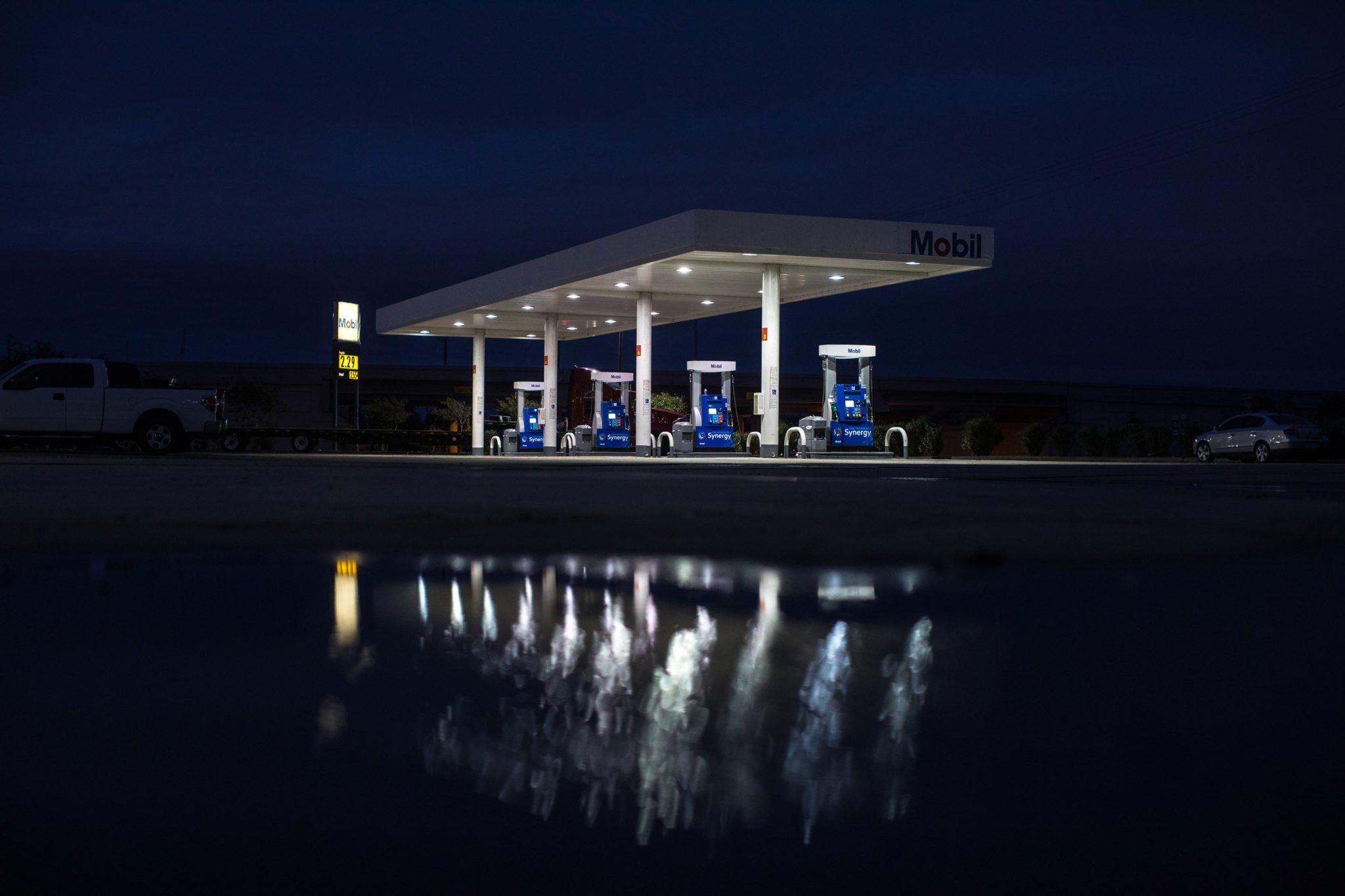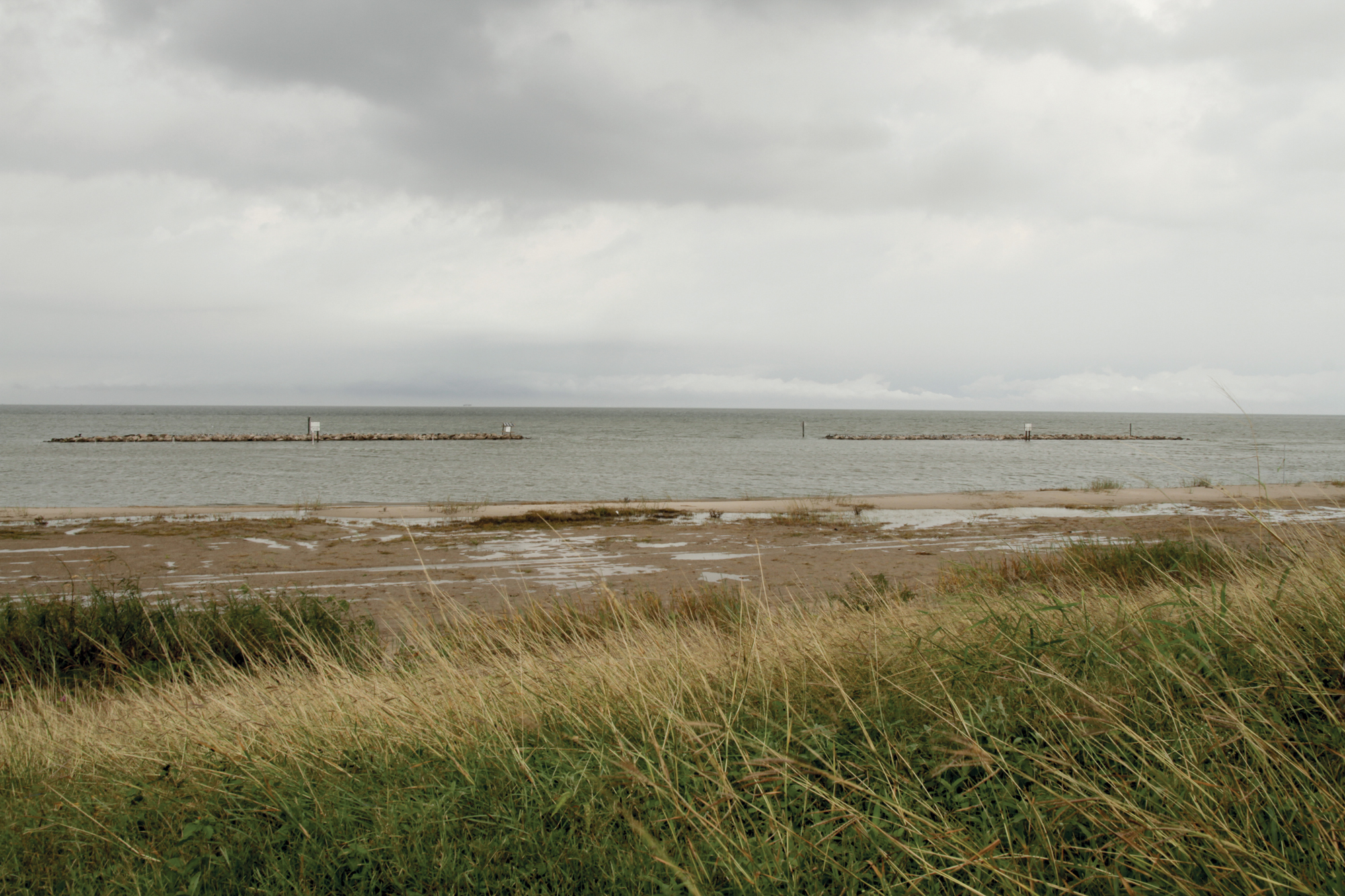
Postcard from the Incredible Electric Oyster Reef
Scientists hope to heal Corpus Christi's troubled waters.

A version of this story ran in the December 2015 issue.
It used to be that the streets were paved with shells.
In the 19th century, a vast oyster reef underneath Nueces Bay formed a kind of road from the small port town of Corpus Christi to settlements on the other side of the bay. Since there were no real streets, people would use the oyster reef to travel across the bay, splashing in their horse and buggies through seawater that rose, clear and shallow, a few feet above it.
From the 1840s through the turn of the 20th century, the population in the Coastal Bend surged, and with it came heavy construction. In Corpus Christi and nearby towns, houses were built and city streets were paved with bricks of shellcrete, a cheap building material mixed from water, sand, and oyster shells mined from the reefs. As recently as 1950, shellcrete was used for constructing houses, and as more people moved to the region, the oyster reefs began to disappear.
By the 1980s, the extensive oyster beds in Corpus Christi and Nueces bays that took tens of thousands of years to accumulate were gone. Without a hard reef, coastal winds churned up the soft bottom of the bays. Murky, sediment-thick water disrupted the marine habitat, and the bays became a giant mud pool no longer capable of supporting an abundance of fish and plant life. The once-clear water now “looks like Yoo-hoo, all of the time,” said Aaron Baxter, a marine biologist at Texas A&M University at Corpus Christi.
Now, just offshore from the edge of the university’s campus, a Texas A&M project is underway to turn back the impact of time and development. A few feet under the water in Corpus Christi Bay is a grid made of thin steel bars, or rebar, and attached to it are solar panels, their poles planted underneath the waves. The rebar grid is a test site for what Texas A&M scientists hope will be followed, eventually, by an artificial, electrified oyster reef spread over 450 acres of Nueces Bay, the smaller, shallower body of water connected to Corpus Christi Bay.
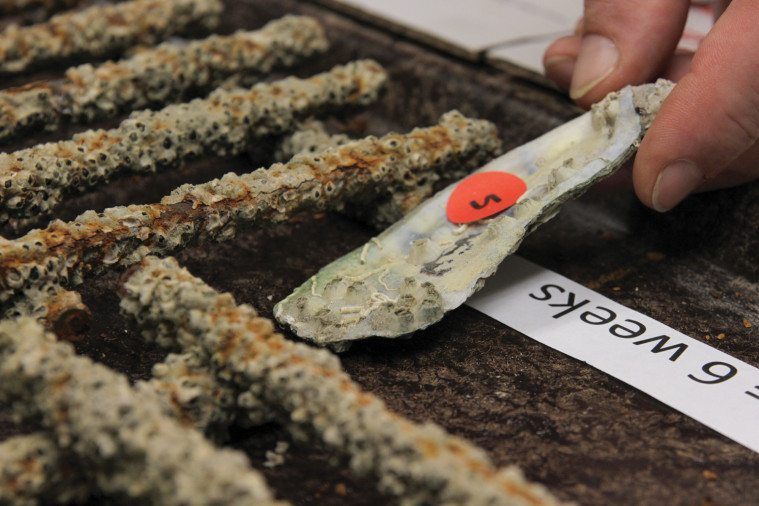
The artificial rebar reef could help regenerate Nueces Bay’s oyster population, but its role in underwater infrastructure is even more vital. Over the next five years or so, researchers hope, the artificial reef will cap the bay’s muddy bottom, help heal the disrupted ecosystem and eventually begin to repopulate it with myriad forms of marine life.
Paul Zimba, director of the Center for Coastal Studies at Texas A&M at Corpus Christi, views his project from the point of view of water quality. “Our goal is basically to improve water quality by hardening the sediment,” he said. “If we can grow oysters — wonderful.”
Trained as a marine botanist, Zimba described the artificial reef this way: “If you put meringue over the top of the lemon pie, the pudding stays wet but the meringue stays hard on the top of it. It keeps the flavor in there and it doesn’t dry out. That’s what we’re looking for with this project.”
Researchers hope the artificial reef will cap the bay’s muddy bottom and help heal the disrupted ecosystem and eventually begin to repopulate it with myriad forms of marine life.
Hence, the electrified artificial oyster reef — a project so counterintuitive it sounds like something out of MacGyver. The structure at the test site in Corpus Christi Bay is a 1,500-pound grid made of rebar cross-hatched to form tiles — a kind of industrial quilt. The attached solar panels electrify the grid, sending current through the water, which, in turn, sets off a chain reaction that attracts living and mineral material.
Though electricity in water sounds like a recipe for disaster, the current is low enough to stimulate mineral growth without harming marine species. Among the first types of growth on the grid is the accumulation of a mineral, calcium carbonate, that attracts both barnacles and oysters; the mineral is familiar to oysters, since it forms their shells. Free-floating oyster spat, or young oysters, anchor themselves to the grid, filter water and eventually establish colonies.
Zimba, whose bright blue eyes and quick smile give him a mischievous look, likes to anthropomorphize oysters. When they come upon carbonate calcium, he says, “It’s kind of like, ‘Ooh, this is almost like home.’” If other surfaces, such as glass or rubber, are offered, “they’ll come along, they’ll attach, [but] they aren’t going to be happy. So really the goal is to come up with a surface that they like.”
In the test phase of the project, Zimba’s team in May installed the six test beds — three artificial and three made from oyster shells. Now researchers are counting the organisms that have colonized the beds to see which type generates more growth. On an overcast day in late October, rebar tiles culled from the test beds were spread out on a conference table at Texas A&M.
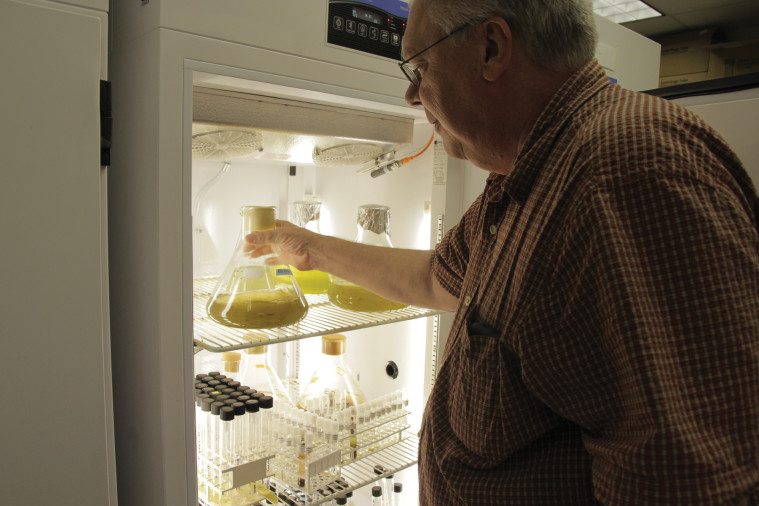
The tiles were arranged chronologically, according to how long they’d been in the water. Six-week tiles showed a solid cover of barnacles that obscured the rebar beneath. A 14-week tile was covered in dusty green barnacles that had doubled the diameter of the rebar to nearly an inch. “In a year’s time we could have something that is around 1 1/2 and 2 inches thick, with multi layers,” Zimba said, adding that it would take several years to achieve that much growth using real shells.
He flipped over a real oyster shell sprinkled with barnacles. “As you have an oyster spat or barnacle land on this, they might go, ‘Oh, this isn’t too bad,’” he said. Then he points to a rebar tile covered in much more dense barnacle growth. “When they get to this, they go, ‘Ooh! Move over, buddy. We want a room with a view!’”
Eventually, researchers hope, the matter accumulating on the tiles will completely fill in the grid, forming a living, mostly solid surface. “Oyster reefs are super-productive habitat types,” Baxter said. “Recreationally, fishing is huge in this area. Lots and lots of people spend lots and lots of money every year here to come down and catch our fish. These reefs have potential to really increase the amount of fish available to recreational fishermen.”
And if the test beds are followed by the 450-acre permanent reef in nearby Nueces Bay, it may help mitigate some of the impact of tropical storms. Like coastal wetlands, oyster reefs are green infrastructure, as opposed to gray infrastructure such as man-made seawalls and levees.
Although the project is barely off the ground, it’s stirring academic controversy, mainly over who gets credit.
The idea for Corpus Christi’s artificial reef came from one of Zimba’s grad students, who, inspired by coral reef restoration, wanted to experiment with building an electric reef for her master’s project. The Ed Rachal Foundation, based in Corpus Christi, provided initial funding, and the Environmental Protection Agency followed with a two-year grant totaling nearly $200,000. If all goes well, Zimba says, the project should secure enough additional federal funding to see it through its five-year timeline.
Although the project is barely off the ground, it’s stirring academic controversy, mainly over who gets credit. In 2007, marine scientist James Cervino, then at Pace University, designed an artificial, electrified reef for oysters in New York City’s East River, where they had been nearly wiped out by overharvesting and pollution. Now, Cervino’s mentor on that project, marine biologist Thomas Goreau, claims the Corpus Christi reef was largely his idea. In the 1980s and 1990s, Goreau worked with scientist Wolf Hilbertz, arguably the inventor of seawater electrolysis. Hilbertz first discovered that electrical current can regrow underwater habitat when he was at the University of Texas at Austin in the late 1970s. Later, he and Goreau engineered the technique to promote coral reef restoration.
In an email to the Observer, Goreau said he and Cervino proposed an oyster restoration project near Galveston a decade ago but the idea was rejected by Texas A&M researchers. “Copying our proposed work is precisely what they then claimed to have ‘discovered,’” he wrote. “This really amounts to plagiarism!”
In response, Zimba told the Observer that Goreau was “not very forthcoming with information” about his project — the usual protocol between academics working on similar research. “We had to start from square one,” he said. Goreau shot back that he never received inquiries from Texas A&M researchers: “All their oyster work has been done in secret without any effort to use our 40 years of experience growing oysters with electricity.”
A complex project such as the electric oyster reef invites more questions than answers, at least in its initial phases. What density of coverage is necessary to re-establish the reef? Does it need to be electrified indefinitely? What implications will the reef have for higher-order species such as large fish and crabs? And inevitably, such new projects run into snags, in some cases produced by Mother Nature.
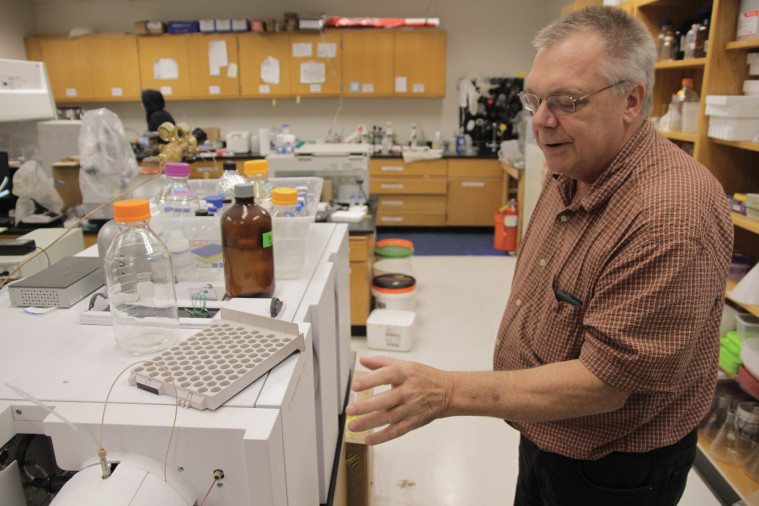
In mid-September, when Zimba’s team expected to install the project’s final phase, a severe red tide swept through the Gulf. Red tides, which come to the Texas Gulf every fall, are giant algae blooms that cover the water’s surface, creating rust-colored streaks that stretch for hundreds of feet. When the organism that causes red tide, Karenia brevis, is churned up in the water, its cells release a neurotoxin, and the effects are brutal.
Dead fish wash ashore and nocturnal animals like coyotes or raccoons, after eating them, wander drunkenly in the streets in broad daylight. The neurotoxin burns eyes and irritates lungs enough to produce a smoker’s cough. When red tide concentrations are at their highest, humans can feel the effect while standing on the shore, so wading into the bay to collect rebar tiles becomes nearly impossible. “The sampling involved with collecting these tiles takes about 45 minutes to an hour, and that exposure is quite a long time,” Zimba said.
As we sat in a conference room next to Zimba’s lab, rain pummeled the roof of the building. A colleague came in to fetch a T-shirt for a student who got caught in the storm. Just that morning, a high-powered system brought a tornado and drenching rain to Central Texas. Because of the severe weather, as well as the red tide, Zimba’s team missed more than a month of sampling. Now, since it’s not clear when the red tide will abate, the team may have to wait until March to install the final phase — a much larger artificial reef, shaped like a massive wagon wheel, with solar panels attached to the hub.
“One reef project is great, but it’s not enough. It needs to be marsh projects, mangroves expanding.”
Ultimately, Zimba says, the Corpus Christi rebar reef will spawn more research into the process of growing oyster reefs. His project, he says, has focused on finding the amount of electrical current that will optimize calcium carbonate growth on the asumption that oysters will then follow. But what if reducing the voltage in the artificial reef and slowing down the accumulation of calcium carbonate is better for the oysters in the long-run?
“Maybe by cutting the voltage down and getting a slower growth rate,” Zimba said, “the oysters will go, ‘Mmm, let’s get this.’”
[Featured image: Sam Mohney]
To support journalism like this, donate to the Texas Observer.


